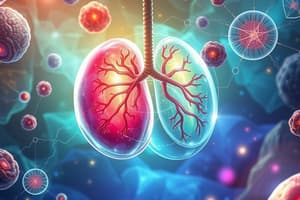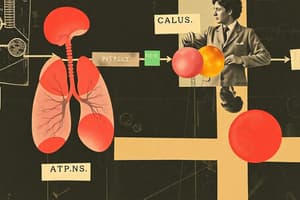Podcast
Questions and Answers
What is the primary function of transaminases in amino acid biosynthesis?
What is the primary function of transaminases in amino acid biosynthesis?
- To transport amino acids across membranes
- To synthesize glucose from amino acids
- To remove amino groups from amino acids
- To move amino groups between molecules (correct)
In which type of medium are the exact nutrient compositions known?
In which type of medium are the exact nutrient compositions known?
- Complex medium
- Defined medium (correct)
- Differential medium
- Selective medium
Why are animal pathogens often cultured in complex media?
Why are animal pathogens often cultured in complex media?
- They do not utilize simple carbon sources
- They grow better in solid media than in liquid media
- They require specific purified chemicals for growth
- They have minimal biosynthetic capacity and need numerous nutrients (correct)
What is the role of ACP in fatty acid biosynthesis?
What is the role of ACP in fatty acid biosynthesis?
What does selective media do?
What does selective media do?
During binary fission, how is cell division characterized?
During binary fission, how is cell division characterized?
What characteristic is associated with liquid media?
What characteristic is associated with liquid media?
What is one advantage of using solid media for microbial growth?
What is one advantage of using solid media for microbial growth?
What is the primary product of glycolysis?
What is the primary product of glycolysis?
What happens to NADH produced during glycolysis?
What happens to NADH produced during glycolysis?
In aerobic conditions, how much ATP is generated from one glucose molecule?
In aerobic conditions, how much ATP is generated from one glucose molecule?
Which molecule serves as the terminal electron acceptor in aerobic respiration?
Which molecule serves as the terminal electron acceptor in aerobic respiration?
What is produced during fermentation under anaerobic conditions?
What is produced during fermentation under anaerobic conditions?
What is the role of ATP Synthase in cells?
What is the role of ATP Synthase in cells?
Which of the following does NOT occur during glycolysis?
Which of the following does NOT occur during glycolysis?
What mechanism allows cells that do not require oxygen to generate a proton motor force?
What mechanism allows cells that do not require oxygen to generate a proton motor force?
What is the role of the divisome during cytokinesis?
What is the role of the divisome during cytokinesis?
Which of the following is a disadvantage of direct count using a Petroff-Hausser counting chamber?
Which of the following is a disadvantage of direct count using a Petroff-Hausser counting chamber?
What is the statistical significance range for counting colonies on a plate?
What is the statistical significance range for counting colonies on a plate?
What does TMTC stand for in the context of colony counting?
What does TMTC stand for in the context of colony counting?
Which method allows for counting in lower concentrations of cells?
Which method allows for counting in lower concentrations of cells?
What is a primary feature of the pour plate method?
What is a primary feature of the pour plate method?
Which of the following statements about cytokinesis is incorrect?
Which of the following statements about cytokinesis is incorrect?
What is the calculated concentration of bacteria if 159 colonies are counted from a total dilution of $10^{-3}$?
What is the calculated concentration of bacteria if 159 colonies are counted from a total dilution of $10^{-3}$?
How many cells will there be after 60 minutes if the initial population (N0) is 2 cells and the generation time (g) is 20 minutes?
How many cells will there be after 60 minutes if the initial population (N0) is 2 cells and the generation time (g) is 20 minutes?
In which phase does microbial growth occur at its maximum rate due to an abundance of nutrients?
In which phase does microbial growth occur at its maximum rate due to an abundance of nutrients?
What method allows for continuous growth of cultures while mimicking low nutrient environments?
What method allows for continuous growth of cultures while mimicking low nutrient environments?
What is the maximum temperature range for mesophiles?
What is the maximum temperature range for mesophiles?
Which type of organism can grow optimally at temperatures exceeding 80°C?
Which type of organism can grow optimally at temperatures exceeding 80°C?
Which group of microorganisms can grow in environments with salt concentrations below 1%?
Which group of microorganisms can grow in environments with salt concentrations below 1%?
What pH range do neutrophiles thrive in?
What pH range do neutrophiles thrive in?
What happens to bacterial growth when there is too little fresh media in a continuous culture?
What happens to bacterial growth when there is too little fresh media in a continuous culture?
What is the function of buffers in artificial mediums?
What is the function of buffers in artificial mediums?
Which of the following characteristics is typical of acidophiles?
Which of the following characteristics is typical of acidophiles?
What is the primary function of the bacterial cell wall?
What is the primary function of the bacterial cell wall?
Which component is not involved in the synthesis of peptidoglycan?
Which component is not involved in the synthesis of peptidoglycan?
Which characteristic is unique to Gram-negative bacteria compared to Gram-positive bacteria?
Which characteristic is unique to Gram-negative bacteria compared to Gram-positive bacteria?
What energy sources drive the active transport system for large proteins across the membrane?
What energy sources drive the active transport system for large proteins across the membrane?
Which structure is specifically referred to as the peptidoglycan layer?
Which structure is specifically referred to as the peptidoglycan layer?
What role do Penicillin-Binding Proteins (PBPs) play in bacterial cell wall synthesis?
What role do Penicillin-Binding Proteins (PBPs) play in bacterial cell wall synthesis?
What links the peptide side chains in the peptidoglycan layer of Gram-negative bacteria?
What links the peptide side chains in the peptidoglycan layer of Gram-negative bacteria?
In the context of microbial cell structure, the term 'cell envelope' encompasses which of the following?
In the context of microbial cell structure, the term 'cell envelope' encompasses which of the following?
Study Notes
Glycolysis Pathway
- Glucose is broken down in a catabolic pathway that does not require oxygen
- 2 ATP are produced from substrate phosphorylation
- Glucose is converted to pyruvate, NADH is produced
Recycling Reduced Coenzymes: Fermentation
- Fermentation occurs in the absence of oxygen
- Fermentation recycles reduced coenzymes: NADH
- This process produces ethanol and lactate
Recycling Reduced Coenzymes: Respiration
- Respiration requires oxygen.
- 2 Pyruvate are converted using cofactors to produce carbon dioxide, NADH, FADH, and GTP
- The Citric Acid/Krebs/TCA cycle is part of respiration
Electron Transport Chain (ETC)
- Oxidizes electron carriers NADH and FADH2
- Protons are pumped across the membrane generating a proton motor force
- Oxygen acts as the terminal electron acceptor
ATP Synthase
- ATP is synthesized by the movement of protons down the gradient
- This enzyme is called ATP Synthase
- ATP Synthase is reversible
Anabolic Metabolism
- Organisms can synthesize sugars, polysaccharides, amino acids, proteins, nucleotides, nucleic acids, fatty acids, and lipids
- Gluconeogenesis produces glucose when it is not available
- Transaminases move amino groups between molecules
- ACP is a carrier for fatty acids
Microbial Division and Growth
- Culture media is used to grow microbes
Defined Medium
- Contains minimum nutrients for growth and is made with purified chemicals
- The exact composition is known
- Good for studying metabolism and physiology
Complex Medium
- Composed of animal digests or plant products
- Needed for microbes with unknown growth requirements
Growth Media
- Selective media inhibits the growth of certain organisms while allowing others to grow
- Differential media provides different visual appearances of colonies
Liquid Medium
- Provides consistent conditions for microbes
Solid Medium
- Used for isolating individual colonies
Bacterial Cell Division
- Binary fission is the division of a cell
Binary Fission
- Occurs in three steps: DNA replication and segregation, cytokinesis, synthesis of a new cell wall
Measuring Population Growth
- Direct Count is done using a Petroff-Hausser counting chamber to count cells rapidly
- Viable Count determines living cells by counting colonies after serially diluting a sample of cells
Growth Phases in Batch Culture
- Lag Phase: The bacteria adapt to new conditions
- Logarithmic (Log) Phase: Rapid growth and nutrient use
- Stationary Phase: Growth slows down due to limited nutrients
- Death Phase: Cells die due to lack of energy for maintenance
Growth in a Continuous Culture
- Continuous cultures are used to grow microbes for an extended period of time
- It is important to maintain adequate nutrient levels and control the growth rate
Factors Affecting Microbial Growth
- Temperature
- pH
- Osmotic strength
- Oxygen levels
Factors Affecting Microbial Growth: Temperature
- Psychrophile: Growth in cold temperatures
- Mesophile: Growth in moderate temperatures
- Thermophile: Growth in hot temperatures
- Hyperthermophile: Growth in very hot temperatures
Factors Affecting Microbial Growth: pH
- Acidophile: Growth in acidic environments
- Neutrophile: Growth in neutral pH environments
- Alkalophile: Growth in alkaline environments
Factors Affecting Microbial Growth: Osmotic Strength
- Nonhalophile: Cannot tolerate high salt concentrations
- Halotolerant: Tolerate some salt concentrations
- Halophile: Requires high salt concentrations
- Extreme Halophile: Requires very high salt concentrations
Factors Affecting Microbial Growth: Oxygen Levels
- Obligate Aerobe: Requires oxygen for growth
- Facultative Anaerobe: Can grow with or without oxygen
- Aerotolerant Anaerobe: Can tolerate oxygen but does not use it for growth
- Obligate Anaerobe: Cannot tolerate oxygen
- Microaerophile: Requires low oxygen levels
Cell Structure and Function Part 2
- Transglycosylase: Forms glycan chains
- Transpeptidase: Cross-links peptide side chains
- Autolysins: Cut glycan chains for cell wall expansion
- Bactoprenol: Lipid carrier for cell wall precursors
- PBPs: Penicillin Binding Proteins catalyze the glycosyl transferase and transpeptidase activities
Bacterial Cell Wall Structures
- Gram-positive bacteria: Have a thick peptidoglycan layer
- Gram-negative bacteria: Have a thin layer of pepotidoglycan
Cell Wall Structures: Peptidoglycan
- The cell wall is made up of interconnected glycan chains
- The cell wall prevents the cell from lysing.
- The cell wall provides the cell with a shape.
- The cell wall is also called murein.
Studying That Suits You
Use AI to generate personalized quizzes and flashcards to suit your learning preferences.
Related Documents
Description
This quiz covers key concepts related to glycolysis, fermentation, respiration, the electron transport chain, and ATP synthesis. You will be tested on your understanding of these metabolic processes and their roles in energy production. Perfect for students studying biochemistry or cellular biology.




